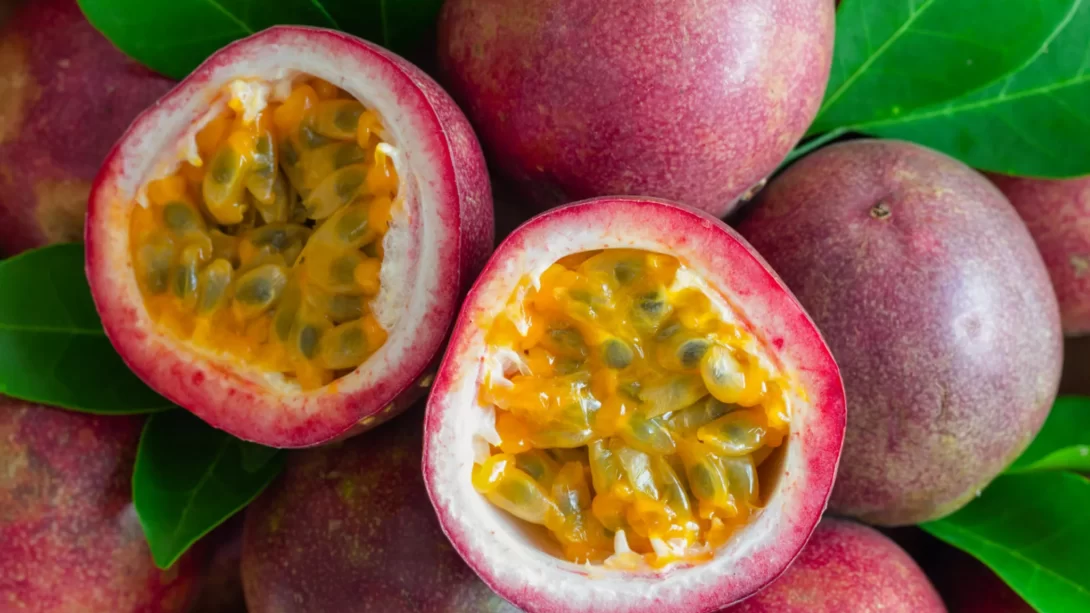Passion fruit, known for its vibrant taste and aromatic flavor, is a popular fruit in many parts of the world. Rich in vitamins and minerals, it’s not only a delicious treat but also a healthy addition to any diet. However, for those unfamiliar with this exotic fruit, knowing how to properly cut and serve it can be a challenge. This article provides a straightforward guide on how to cut passion fruit, ensuring you can fully enjoy its unique taste and nutritional benefits.
Passion Fruit
Passion fruit comes in various varieties, most commonly the purple-skinned and the larger yellow-skinned types. Each type has a distinctive taste and texture, but all share the common feature of a tough outer rind encasing a juicy, seed-filled interior.
The ripeness of passion fruit is key to its flavor. A ripe passion fruit is slightly wrinkled and feels heavy for its size, indicating a juicy interior. The skin color can also signal ripeness, with deeper hues typically signifying a riper fruit.
Nutritionally, passion fruit is a powerhouse, packed with vitamin C, dietary fiber, and beneficial plant compounds. It’s often eaten fresh, used as a topping for desserts, or incorporated into beverages and sauces.
Preparing to Cut Passion Fruit
Before cutting into a passion fruit, selecting a ripe one is crucial for the best flavor. Look for fruits with a slightly wrinkled skin that yield to gentle pressure. Before cutting, wash the fruit under running water to remove any dirt or residue.
You’ll need a sharp knife and a cutting board to cut passion fruit. A dull knife can squash the fruit, making it harder to separate the pulp from the rind.
Step-by-Step Guide to Cutting Passion Fruit
Cutting passion fruit is a simple process. Here’s how you can do it:
Step 1: Stabilizing the Fruit on the Cutting Board
Place the passion fruit on a stable cutting board. To prevent the fruit from rolling, you can trim a small piece off the bottom to create a flat surface.
Step 2: Cutting the Passion Fruit in Half
Hold the fruit firmly and slice it in half with a sharp knife. You can cut it lengthwise or crosswise. Either way, you’ll be greeted with the vibrant, seed-filled interior.
Step 3: Scooping Out the Pulp
Use a spoon to gently scoop out the pulp and seeds from each half. The pulp is the edible part of the fruit, containing both the juice and seeds.
Alternative Methods of Cutting for Different Presentations
- For a decorative presentation, you can make a zigzag cut around the center of the fruit before pulling it apart.
- If you plan to use the passion fruit shell as a serving bowl, take care not to pierce through the bottom while scooping out the pulp.
Tips for Enjoying Passion Fruit
Passion fruit can be enjoyed in several ways:
- Eating Raw: The simplest way to enjoy passion fruit is to eat the pulp and seeds directly from the shell. The seeds are edible and provide a crunchy texture.
- In Recipes: Passion fruit pulp can be used in smoothies, yogurt, salads, desserts, and as a topping for ice cream. Its tangy flavor pairs well with sweet and savory dishes.
- As a Beverage: The pulp can be strained to make juice, which can be used in cocktails, mocktails, or simply diluted with water for a refreshing drink.
Storage Advice for Cut Passion Fruit
Proper storage is essential to maintain the freshness and flavor of cut passion fruit:
- Refrigeration: Store the scooped pulp or the remaining half of a cut passion fruit in an airtight container. It can be refrigerated for up to a week.
- Freezing: For longer preservation, passion fruit pulp can be frozen. Place the pulp in ice cube trays or freezer-safe containers. Frozen passion fruit pulp can be used directly in smoothies or thawed for other uses.
- Preventing Oxidation: To keep the cut surface of a half passion fruit from drying out or becoming brown due to oxidation, you can lightly brush it with lemon juice before storing.
Creative Culinary Uses of Passion Fruit
Beyond eating it raw, passion fruit can add a tropical twist to various dishes:
- Dressings and Sauces: The tangy flavor of passion fruit makes it an excellent base for salad dressings, marinades, or sweet sauces for desserts.
- Baking: Incorporate passion fruit pulp into cakes, tarts, and pastries for a unique flavor. It pairs well with cream-based fillings and toppings.
- Exotic Toppings: Use passion fruit as a topping for pancakes, waffles, or oatmeal. Its vibrant taste can enhance the flavor profile of these breakfast staples.
Conclusion
Cutting and enjoying passion fruit is a simple yet rewarding culinary experience. Whether eaten on its own, used as a flavorful addition to beverages and dishes, or incorporated into creative recipes, passion fruit offers a delightful taste and numerous health benefits. By following the steps outlined in this guide, you can easily prepare and store passion fruit, ensuring that this exotic treat is always within reach in your kitchen. Embrace the versatility of passion fruit and let its unique flavor inspire your culinary adventures.




